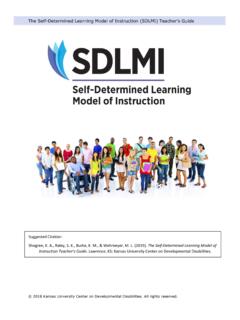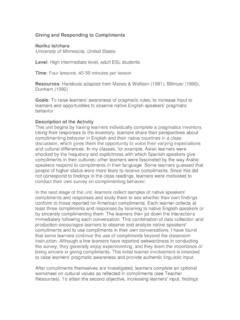Transcription of TensorFlow - Tutorialspoint
1 TensorFlow i TensorFlow i About the Tutorial TensorFlow is an open source machine learning framework for all developers. It is used for implementing machine learning and deep learning applications. To develop and research on fascinating ideas on artificial intelligence, Google team created TensorFlow . TensorFlow is designed in Python programming language, hence it is considered an easy to understand framework. Audience This tutorial has been prepared for python developers who focus on research and development with various machine learning and deep learning algorithms. The aim of this tutorial is to describe all TensorFlow objects and methods. Prerequisites Before proceeding with this tutorial, you need to have a basic knowledge of any Python programming language.
2 Knowledge of artificial intelligence concepts will be a plus point. Copyright & Disclaimer Copyright 2018 by Tutorials Point (I) Pvt. Ltd. All the content and graphics published in this e-book are the property of Tutorials Point (I) Pvt. Ltd. The user of this e-book is prohibited to reuse, retain, copy, distribute or republish any contents or a part of contents of this e-book in any manner without written consent of the publisher. We strive to update the contents of our website and tutorials as timely and as precisely as possible, however, the contents may contain inaccuracies or errors. Tutorials Point (I) Pvt. Ltd. provides no guarantee regarding the accuracy, timeliness or completeness of our website or its contents including this tutorial.
3 If you discover any errors on our website or in this tutorial, please notify us at TensorFlow ii Table of Contents About the Tutorial .. i Audience .. i Prerequisites .. i Copyright & Disclaimer .. i Table of Contents .. ii 1. TensorFlow Introduction .. 1 Why is TensorFlow So Popular? .. 1 2. TensorFlow Installation .. 3 3. TensorFlow Understanding Artificial Intelligence .. 8 Supervised Learning .. 9 Unsupervised Learning .. 9 4. TensorFlow Mathematical Foundations .. 11 Vector .. 11 Mathematical Computations .. 12 5. TensorFlow Machine Learning and Deep Learning .. 15 Machine Learning .. 15 Deep Learning .. 15 Difference between Machine Learning and Deep learning .. 16 Applications of Machine Learning and Deep Learning.
4 17 6. TensorFlow 19 Tensor Data Structure .. 19 Various Dimensions of TensorFlow .. 20 Two dimensional Tensors .. 21 Tensor Handling and Manipulations .. 23 7. TensorFlow Convolutional Neural 25 Convolutional Neural Networks .. 25 TensorFlow iii TensorFlow Implementation of CNN .. 27 8. TensorFlow Recurrent Neural Networks .. 31 Recurrent Neural Network Implementation with TensorFlow .. 32 9. TensorFlow TensorBoard Visualization .. 36 10. TensorFlow Word Embedding .. 38 Word2vec .. 38 11. TensorFlow Single Layer Perceptron .. 42 Single Layer Perceptron .. 43 12. TensorFlow Linear Regression .. 47 Steps to design an algorithm for linear regression .. 48 13. TensorFlow TFLearn and its installation.
5 50 14. TensorFlow CNN and RNN Difference .. 52 15. TensorFlow Keras .. 53 16. TensorFlow Distributed Computing .. 56 17. TensorFlow Exporting with TensorFlow .. 58 18. TensorFlow Multi-Layer Perceptron Learning .. 59 19. TensorFlow Hidden Layers of Perceptron .. 63 20. TensorFlow Optimizers in TensorFlow .. 67 21. TensorFlow XOR Implementation .. 68 22. TensorFlow Gradient Descent Optimization .. 71 23. TensorFlow Forming Graphs .. 73 24. TensorFlow Image Recognition using TensorFlow .. 77 25. TensorFlow Recommendations for Neural Network Training .. 82 TensorFlow 1 TensorFlow is a software library or framework, designed by the Google team to implement machine learning and deep learning concepts in the easiest manner.
6 It combines the computational algebra of optimization techniques for easy calculation of many mathematical expressions. The official website of TensorFlow is mentioned below: Let us now consider the following important features of TensorFlow : It includes a feature of that defines, optimizes and calculates mathematical expressions easily with the help of multi-dimensional arrays called tensors. It includes a programming support of deep neural networks and machine learning techniques. It includes a high scalable feature of computation with various data sets. TensorFlow uses GPU computing, automating management. It also includes a unique feature of optimization of same memory and the data used.
7 Why is TensorFlow So Popular? TensorFlow is well-documented and includes plenty of machine learning libraries. It offers a few important functionalities and methods for the same. TensorFlow is also called a Google product. It includes a variety of machine learning and deep learning algorithms. TensorFlow can train and run deep neural networks for 1. TensorFlow Introduction TensorFlow 2 handwritten digit classification, image recognition, word embedding and creation of various sequence models. TensorFlow 3 To install TensorFlow , it is important to have Python installed in your system. Python version + is considered the best to start with TensorFlow installation. Consider the following steps to install TensorFlow in Windows operating system.
8 Step 1: Verify the python version being installed. Step 2: A user can pick up any mechanism to install TensorFlow in the system. We recommend pip and Anaconda . Pip is a command used for executing and installing modules in Python. Before we install TensorFlow , we need to install Anaconda framework in our system. 2. TensorFlow Installation TensorFlow 4 After successful installation, check in command prompt through conda command. The execution of command is displayed below: TensorFlow 5 Step 3: Execute the following command to initialize the installation of TensorFlow : conda create --name TensorFlow python= It downloads the necessary packages needed for TensorFlow setup. Step 4: After successful environmental setup, it is important to activate TensorFlow module.
9 Activate TensorFlow Step 5: Use pip to install TensorFlow in the system. The command used for installation is mentioned as below: pip install TensorFlow TensorFlow 6 And, pip install TensorFlow -gpu After successful installation, it is important to know the sample program execution of TensorFlow . TensorFlow 7 Following example helps us understand the basic program creation Hello World in TensorFlow . The code for first program implementation is mentioned below: >> activate TensorFlow >> python (activating python shell) >> import TensorFlow as tf >> hello = ( Hello, TensorFlow ! ) >> sess = () >> print( (hello)) TensorFlow 8 Artificial Intelligence includes the simulation process of human intelligence by machines and special computer systems.
10 The examples of artificial intelligence include learning, reasoning and self -correction. Applications of AI include speech recognition, expert systems, and image recognition and machine vision. Machine learning is the branch of artificial intelligence, which deals with systems and algorithms that can learn any new data and data patterns. Let us focus on the Venn diagram mentioned below for understanding machine learning and deep learning concepts. Machine learning includes a section of machine learning and deep learning is a part of machine learning. The ability of program which follows machine learning concepts is to improve its performance of observed data. The main motive of data transformation is to improve its knowledge in order to achieve better results in the future, provide output closer to the desired output for that particular system.











